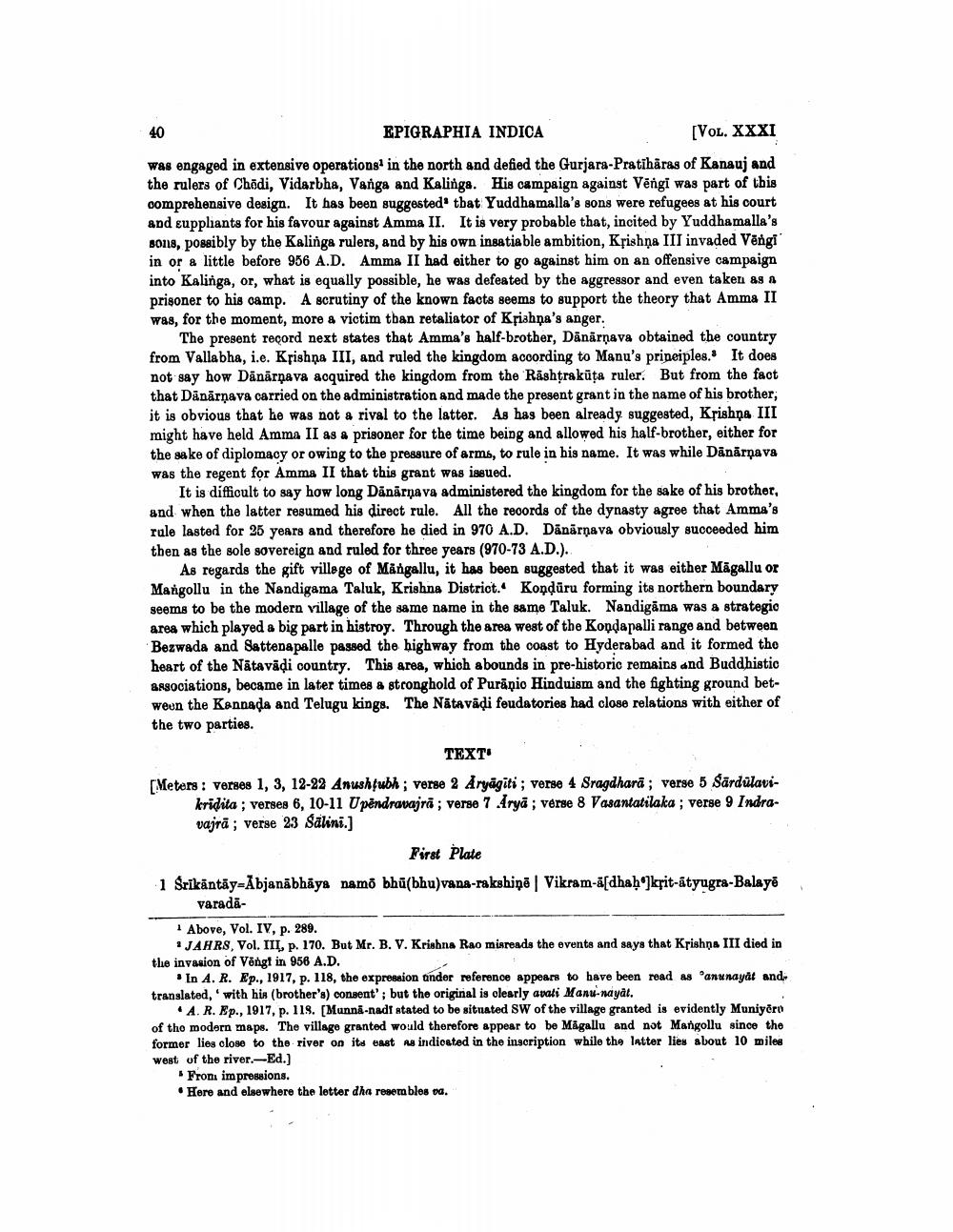________________
40
EPIGRAPHIA INDICA
[VOL. XXXI was engaged in extensive operations1 in the north and defied the Gurjara-Pratihāras of Kanauj and the rulers of Chedi, Vidarbha, Vanga and Kalinga. His campaign against Vengi was part of this comprehensive design. It has been suggested that Yuddhamalla's sons were refugees at his court and suppliants for his favour against Amma II. It is very probable that, incited by Yuddhamalla's sons, possibly by the Kalinga rulers, and by his own insatiable ambition, Krishna III invaded Vengi in or a little before 956 A.D. Amma II had either to go against him on an offensive campaign into Kalinga, or, what is equally possible, he was defeated by the aggressor and even taken as a prisoner to his camp. A scrutiny of the known facts seems to support the theory that Amma II was, for the moment, more a victim than retaliator of Krishna's anger.
The present record next states that Amma's half-brother, Danarnava obtained the country from Vallabha, i.e. Krishna III, and ruled the kingdom according to Manu's principles. It does not say how Danarnava acquired the kingdom from the Rashtrakuta ruler. But from the fact that Dänarnava carried on the administration and made the present grant in the name of his brother, it is obvious that he was not a rival to the latter. As has been already suggested, Krishna III might have held Amma II as a prisoner for the time being and allowed his half-brother, either for the sake of diplomacy or owing to the pressure of arms, to rule in his name. It was while Dānārņava was the regent for Amma II that this grant was issued.
It is difficult to say how long Danarnava administered the kingdom for the sake of his brother, and when the latter resumed his direct rule. All the records of the dynasty agree that Amma's rule lasted for 25 years and therefore he died in 970 A.D. Danarnava obviously succeeded him then as the sole sovereign and ruled for three years (970-73 A.D.)..
As regards the gift villege of Mangallu, it has been suggested that it was either Magallu or Mangollu in the Nandigama Taluk, Krishna District. Kondūru forming its northern boundary seems to be the modern village of the same name in the same Taluk. Nandigama was a strategic area which played a big part in histroy. Through the area west of the Kondapalli range and between Bezwada and Sattenapalle passed the highway from the coast to Hyderabad and it formed the heart of the Nätavadi country. This area, which abounds in pre-historic remains and Buddhistic associations, became in later times a stronghold of Puranic Hinduism and the fighting ground between the Kannada and Telugu kings. The Nätavadi feudatories had close relations with either of the two parties.
TEXT
[Meters: verses 1, 3, 12-22 Anushṭubh; verse 2 Aryägiti; verse 4 Sragdhara; verse 5 Särdülavikridita; verses 6, 10-11 Upendravajra; verse 7 Arya; verse 8 Vasantatilaka; verse 9 Indravajra; verse 23 Sälini.]
First Plate
1 Śrīkāntāy=Ābjanābhāya namō bhū(bhu)vana-rakshiņē| Vikram-a[dhaḥ ]krit-átyugra-Balaye varada
Above, Vol. IV, p. 289.
2 JAHRS, Vol. III, p. 170. But Mr. B. V. Krishna Rao misreads the events and says that Krishna III died in the invasion of Vöngt in 956 A.D.
In A. R. Ep., 1917, p. 118, the expression under reference appears to have been read as "anunayat and translated,' with his (brother's) consent'; but the original is clearly avati Manu-nayat.
A. R. Ep., 1917, p. 118. [Munna-nadi stated to be situated SW of the village granted is evidently Muniyere of the modern maps. The village granted would therefore appear to be Magallu and not Mangollu since the former lies close to the river on its east as indicated in the inscription while the latter lies about 10 miles west of the river.-Ed.]
From impressions.
• Here and elsewhere the letter dha resembles va.




